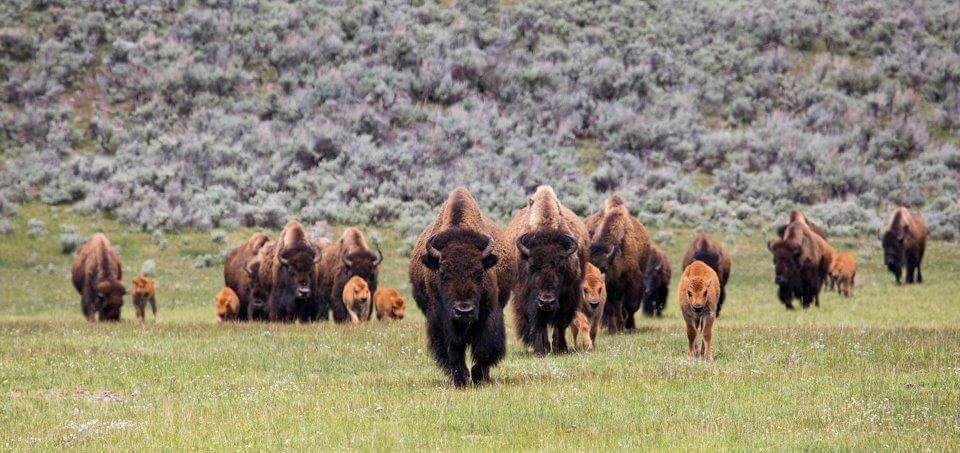
Most buffalo calves in a herd are born during a period of 3 or 4 weeks. Here the red-gold color of all calves reveals their age. These are within 3 months of birth, soon changing to darker color of mothers. National Park Service photo.
Birth Synchrony refers to the short period of time in the spring during which most buffalo calves are born. Typically, the main birthing season occurs within three or four weeks in spring, even though bulls may run with the cows all year around.
In the long history of Buffalo evolving on the plains of North America, birth synchrony is considered an adaptation that insures that most calves are born at the time they are most likely to survive. This applies to Plains Buffalo and probably even more acutely to Wood buffalo of the far north.
Because of long cold winters, the window of time for optimal survival of buffalo calves is especially short in the far north reaches of Canada where Wood buffalo live on the open range. Often pregnant cows come through winter in a semi-starved condition.
Then almost suddenly grass greens up. It’s the birthing season. Winter semi-starvation gives way to spring’s tender and nutritious plant growth.
This provides the best food of the year for mothers and their young calves. Milk production is at an all-time high soon after mothers give birth.
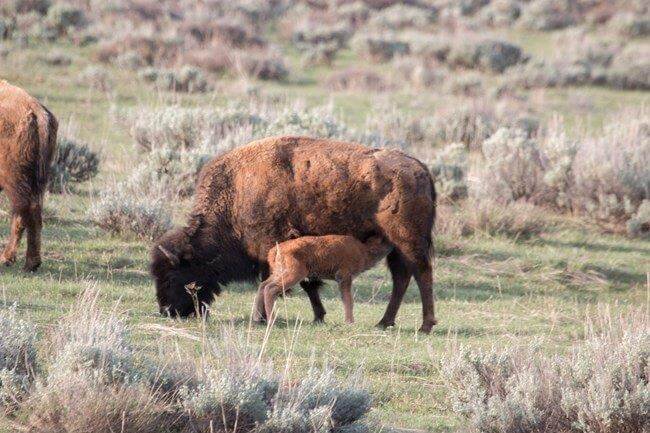
Best milk of the year is available when grass greens-up. Both mother and calf eat well. Credit Tobiason, NPS.
Birth Timing Relates to Seasonal Changes
Scientists who study birth synchrony in buffalo find evidence that the timing of giving birth is strongly related to seasonal changes in their food supply and quality. The timing of birth is important in survival.
Yet the mothers generally get bred during warm fall days. Who knows when spring green-up will occur? And it varies widely year to year.
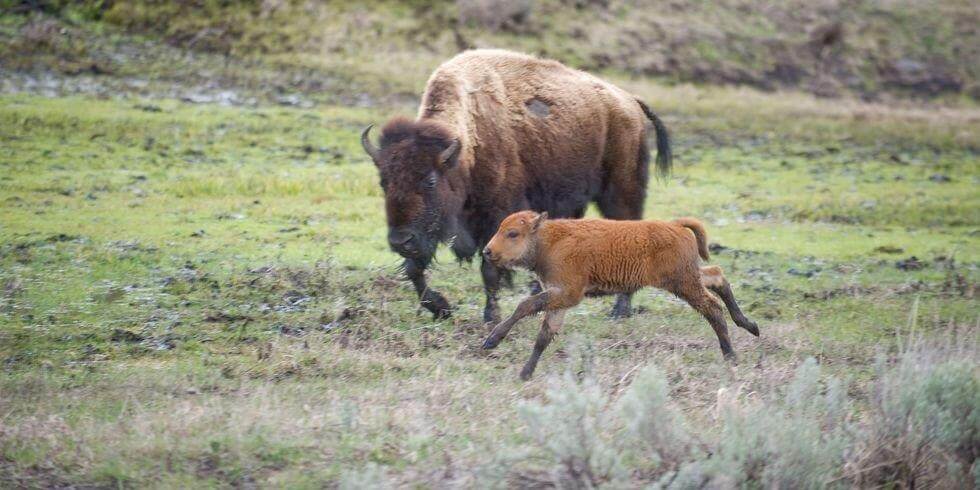
Almost immediately after birth the newborn calf can run with the herd.
Another factor in the tightness of Birth Synchrony may be the presence of large predators such as wolves. In areas where wolves threaten buffalo herds with big, ruthless packs—as was the case for all buffalo thousands of years ago—it is much safer for a calf to be one of many other calves in the middle of a herd.
August and September are the months when mating occurs for the American Bison. The gestation period is about 285 days long—or around 9.5 months.
Mothers usually give birth to a single calf that will nurse for about a year if she continues to have milk—or until the next calf is born. They may give birth to twins and even triplets, but it is difficult for most buffalo mothers to bond with and feed more than one calf.
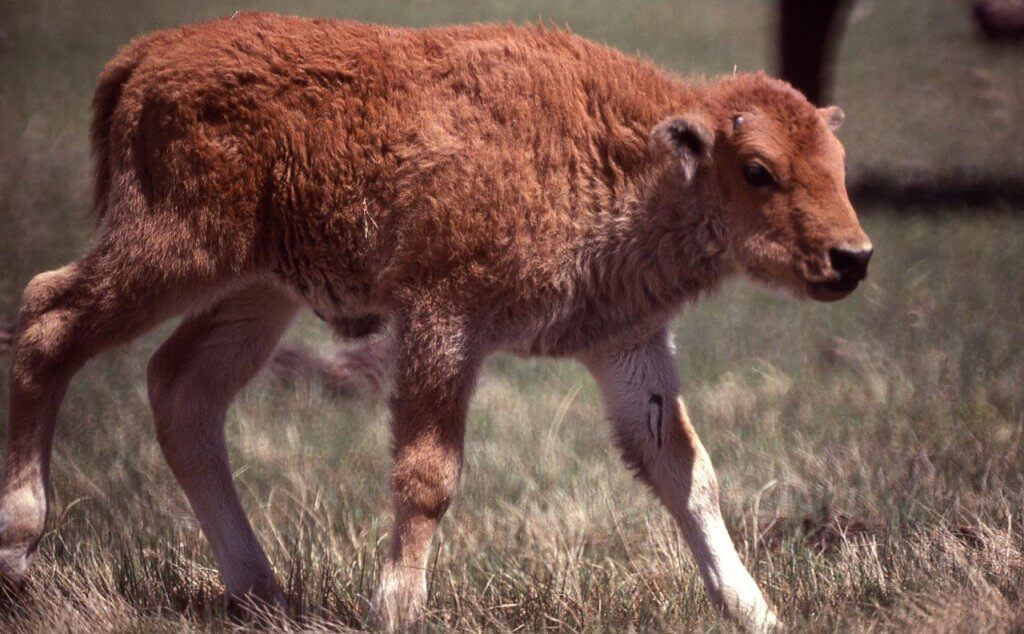
At about 3 months old the buffalo calf grows a hump, tiny horn nubbins appear and he begins changing to a darker color like his mom. NPS.
Bison heifers are considered mature and can be bred at 2 or 3 years old. With good management in commercial herds today, cows can live 30 years or more and raise a calf every year.
Males reach maturity about age 3 but do not usually breed until about 6 years old—when they have grown large enough to compete with other bulls. This may depend on how many mature bulls are in the herd.
Pennsylvania State Extension recommends at least one bison bull for 10 to 15 cows. In today’s ranch herds, young bison bulls between 18 and 36 months of age are often sold for meat, byproducts and breeding stock.
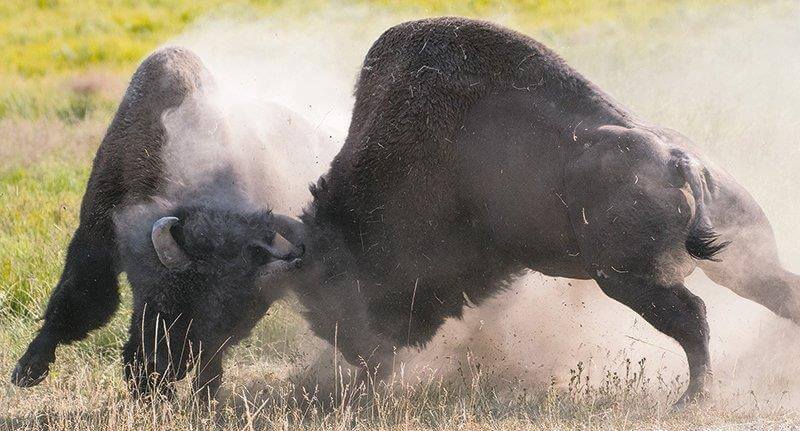
Having too many mature bulls in the herd results in more fighting for supremacy. Younger and smaller bulls usually decline to fight and walk away. NPS.
This cuts down on having too many bulls in the herd and excessive fighting during rut. In open range situations, such as in northern Canada more young bulls may remain with the herds.
How Birth Synchrony Works
There are distinct advantages when most calves are born during an optimal window of time.
For instance, calving of American bison was studied at the National Bison Range, Montana, in 1982. Approximately 80% of the calves were born within three weeks–the last week of April and first 2 weeks of May.
Thus in a herd of 100 cows, most of which raise a calf every year—as in well-managed commercial herds today with good grazing conditions and safety from predators—nearly 80 calves might be born during the last week of April and the first 2 weeks of May.
Another 5 calves might be born earlier and 15 later, perhaps dragging out until the end of July. Although in some cases the last calf delays until September or even December.
During that time at the Bison Range, cow-calf pairs grouped together with other cow-calf pairs rather than with cows without calves.
Was this banding together a natural defense against predators, even though there may no longer be viscous wolves in the vicinity at all? Well fed, the powerful bison mothers were well prepared to fight off attacking bands of wolves and coyotes.
However, scientists say climatic factors appear to be the best explanation of birth synchrony in bison.
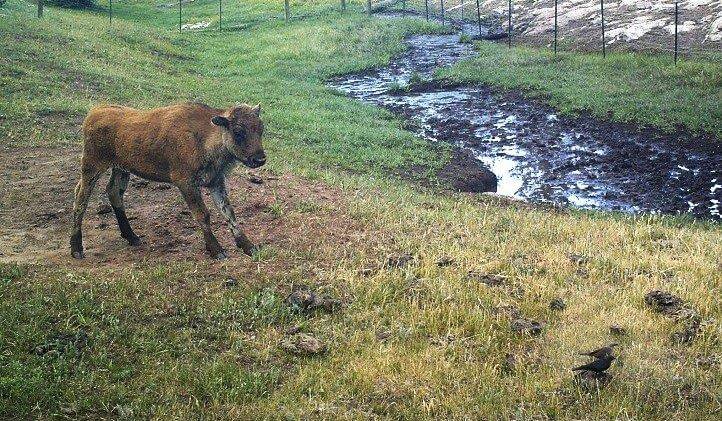
By four months of age black hair shows up on head and legs of bison calves and they take on their mothers’ dark coloring. Hump rises between the shoulder blades.
Parturition: The Process of Birth
Parturition means the process of giving birth—also known as labor. It signals the procedure of delivery after the completion of pregnancy. The developed calf is born with the release of cortisol.
During parturition the cervix dilates and relaxes. Along with cortisol, oxytocin and estrogen hormones are released to begin the milk production and the process of birth.
The uterus contracts to push the fetus toward the cervix and continues until the fetus comes down the birth canal.
After parturition, the uterus releases the placenta and it passes out immediately after the calf is born.
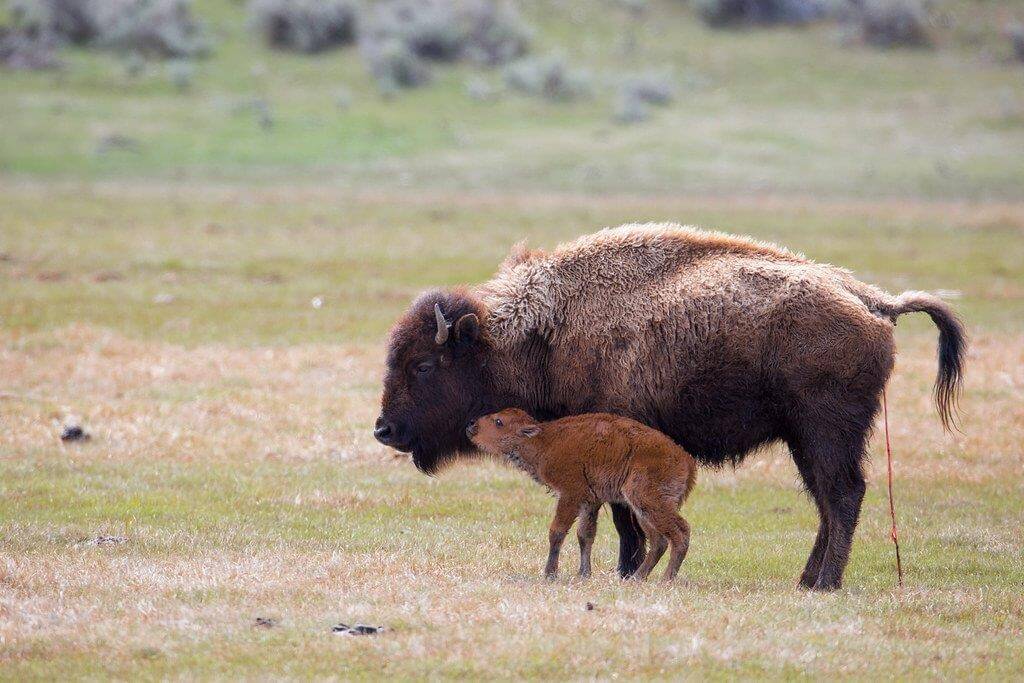
The afterbirth or placenta passes out right after the calf is born. He’s soon up looking for milk and gaining strength in his running legs. NPS.
The first milk is called colostrum and lactation begins. This milk contains antibodies, which is required for newborns to protect them against infectious diseases.
Are Baby Buffalo Hiders or Followers?
This “follower” strategy—which contrasts with hoofed mammals such as elk and deer whose young initially hide under cover —makes sense for bison and many other open-country ungulates, given how exposed their offspring are.
Some smaller grassland grazers, however—including mule deer and the pronghorn antelope that share the American plains with bison—are “hiders” as newborns.
In American Bison: A Natural History, zoologist Dale Lott noted that infant bison usually take no longer than seven or eight minutes to stand up.
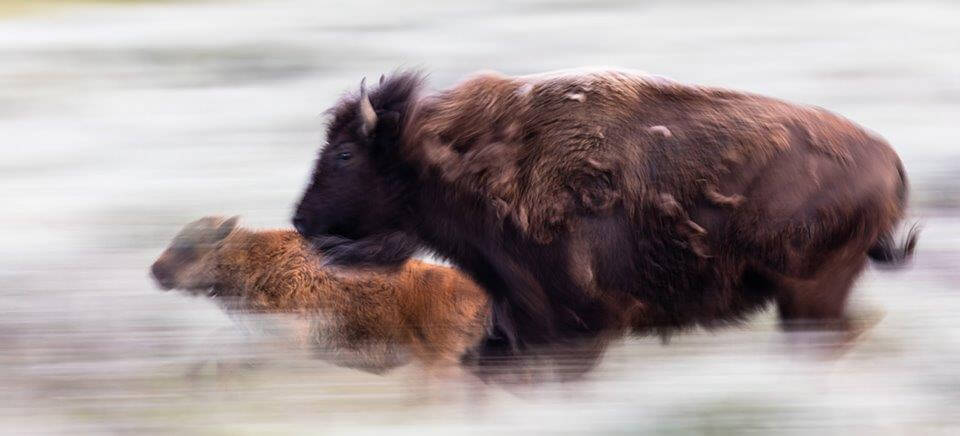
Bison calves are born fully developed and able to run shortly after birth. They are ‘followers’ that stick with mothers and run in the herd, rather than hiding behind in the grass like baby deer.
In that narrow window of relative helplessness, however, a freshly delivered baby buffalo certainly makes a tempting target for a coyote or wolf. But as recent Yellowstone incidents demonstrate, the presence of a horned, half-ton mother is usually enough to thwart predators.
Bison cows often isolate themselves to give birth, but once the calf is able to move, the pair rejoins the herd. A newborn moving about within the group is already that much less vulnerable than if they are hiding in the grass.
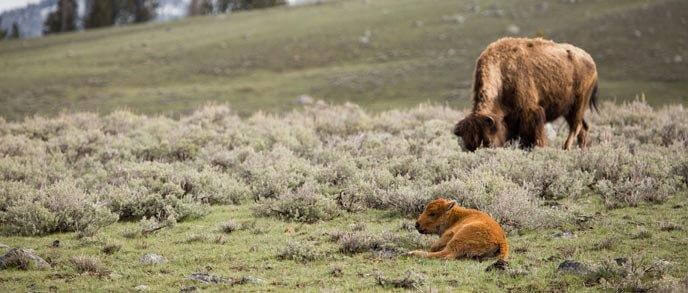
Mother stays close to newborn, as she grazes in the sagebrush.
In Wood Buffalo National Park on the boreal border of Alberta and Northwest Territories, wolves—a much more formidable potential bison predator than a coyote—selectively target bison herds with calves in early summer, but youngsters often escape by fleeing within or in front of the herd, or are saved by an active, belligerent defense from both cows and bulls.
National Parks in Northern US
During a five-year study in Badlands National Park, SD researchers recorded the onset of parturition by Plains Bison between April 3 and 7, with a median birth date of May 2–8.
In Wind Cave National Park, South Dakota, they reported the first births of bison on April 4–7, peaking in late April or early May; although varying among years, the mean length of the birth season, which they defined as period over which 80% of births occurred—was 53.7 ± 10.2 days.
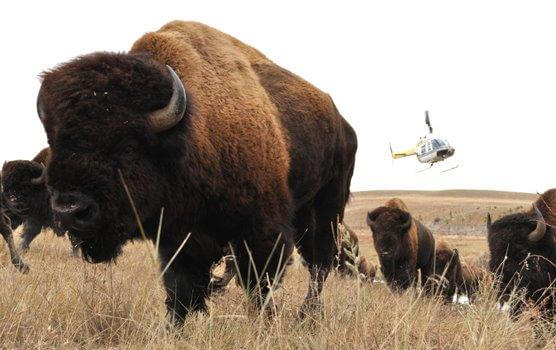
In mountains and badlands, calving is often monitored by aerial count from airplane or heliocopter.
In Yellowstone National Park, Wyoming, predicted parturition has varied widely among years and herds, with the onset occurring from March 31 to April 12 and April 10–27 for the Northern and Central herds, respectively.
The median date of parturition for these herds differed by 16 days (May 6 and May 22), indicating variation in the timing of births even among closely adjacent populations.
In all these populations of Plains Bison, the length of the birthing season varied annually, but largely began in early April and concluded by mid- to late June.
A few calves were born abnormally late, including into September for most studied populations of Plains Bison, and, in exceptional cases, into November in Wind Cave and Yellowstone national parks.
Canada—The Yukon
The birthing season for ungulates (which are primarily large mammals with hooves such as bison, elk, moose and caribou) living at high latitudes is short. In northern North America, birth for most of these occurs within four weeks, beginning in mid-May, peaking in late May, and tapering off by mid-June, according to research in 1998.
Where the environment is distinctly seasonal, there is strong selection toward synchrony or grouping for births—both within and between species—likely in response to a short growing season and, perhaps also the pressure of large predators.
Births outside this “birth pulse” is of interest because it aids in better understanding the stretching out in the timing of births. Alternatively, it may reveal a faulty adaptation if survival or fitness is compromised for early or late born animals.
The timing of parturition in high-latitude populations of Bison is not well studied—and much of the documentation was done in aerial surveys at some distance since these are free-ranging buffalo in the mountains.
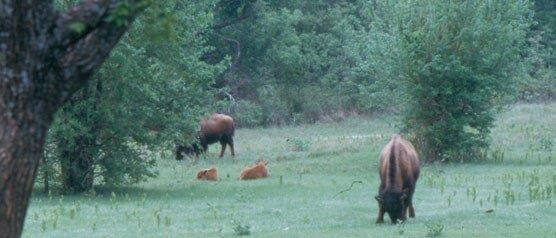
Timing of births in the far north is not well studied with free-ranging buffalo in the mountains. Much of it is done with aerial surveys and photography.
But previous observations have indicated that births do not start until mid-May and largely end in late June or early July, similar to those of other far northern grass-eaters.
In three high-latitude Bison populations in northwestern Canada, the onset of parturition (births) occurred as early as late March and early April—5–6 weeks earlier than previously observed—and two isolated cases of late births occurred in mid-November and mid-December.
These observations suggest that the onset of the birth process in high-latitude Bison can be earlier than previously known, and late births, while apparently rare, may occur.
Determining whether this signals a substantial, lasting shift in the timing and, possibly, synchrony of parturition in high-latitude populations of Bison will require further monitoring of early-born calves.
Most data on the timing of parturition of Bison are from populations at lower latitudes.
Free-ranging Wood Buffalo in Far North
Unfortunately, similar field data are not available for birth dates of free-ranging Wood Bison, which occur at high latitudes, where seasonal constraints are more pronounced.
Geographic variation in the timing of Bison births has been postulated, with the onset of parturition and median birth date later and synchronicity, or tightness of births greater in northern than in southern populations.
For mountain sheep one study found a strong link between latitude and the onset of birth, with later dates of first births in more northern populations.
Similarly, for Wood Bison, the onset of first births in Wood Buffalo National Park, Alberta and Northwest Territories, was reported as May 10 and 12. This was more than a month later than observed for Plains Bison in the US.
Anecdotal observations from field surveys in northwestern Canada over the past 16 years show that early births by Wood Bison largely occur at about the same time as that for Caribou and Moose.
However, it may start earlier, such as early May, and end later, in late June. This suggests that spring green-up of forage also strongly influences the timing of calving by Bison at high latitudes.
Births outside this period have not been observed.
Allen T. Rutberg writes in Journal of Mammalogy, August 24, 1984, “We document recent observations of unusually early- or late-born Bison calves from three reintroduced populations in northwestern Canada.
“Our observations were from the Aishihik population in southwestern Yukon, Canada and the Nahanni and Nordquist populations, which occur at the nexus of the Northwest Territories, Yukon, and British Columbia, Canada, all located between 59°N and 61°N.
“These populations were monitored irregularly by wildlife management agency personnel during the parturition period. We used the description of coat color changes in Bison calves to crudely estimate the parturition date of those born late.
Early-born Calves
“On April 4, 2013, we observed a calf from the Nahanni population, which was assumed born the previous day. In 2015 and 2016, we observed Bison calves from the Aishihik population, presumably born in early April, with the earliest calf seen on April 4, 2016.
“Further, in the first week of April 2016 and 2017, lactating females that had recently been suckled were observed in the Aishihik population.
“Based on a physical examination of the uterine tract of two lactating Bison shot during April 4–6, 2016, these females may have recently given birth.
“For a lactating female shot on April 5, 2017, the predicted birth date was possibly mid-March, based on measurements of the uterus. We note, however, that lactation itself is not unequivocal evidence that the female recently gave birth, as she may have been suckling her calf from the previous year.”
Late-born Calves
March 17, 2005
Reddish-brown calf in a group of 11 Bison near Haines Junction, Yukon Aishihik, noticeably smaller than other calves in the area. We estimated that the calf was probably 10–13 weeks old when observed and, thus, likely born in mid-December.
January 7, 2012
Small calf with a reddish coat in a group of 26 Bison near Liard River, Nordquist British Columbia, about 30–40% the size of seven other calves in the group. Based on descriptions of size and coloration and photographs, we estimate that the calf was probably 8–10 weeks old when observed and, thus, was born in early to mid-November.
Bison born late were rarely recorded; however, we documented two instances from two populations in northwestern Canada. These calves were substantially smaller than other calves observed, and pelage color also differed. Based on descriptions of size and coloration and photographs, we estimate that these calves were born in mid-December and early to mid-November.
Shifting Dates of Birth Synchrony
“Our observations provide evidence of parturition in early April, and possibly as early as late March, in at least two high-latitude populations of Wood Bison—5–6 weeks earlier than reported from Wood Buffalo National Park and earlier observations for the Aishihik and Nahanni populations by wildlife management agency biologists and conservation officers.
“It is uncertain whether the earlier onset of parturition has occurred previously and gone unnoticed or if there has been a shift in the date of first births in recent years.
“We believe that the latter is more plausible, given that observations of Bison in late March and April by wildlife management agency personnel, Bison hunters, and local residents have not included any reports of calves born earlier than May before 2013.
“Detailed studies of the timing of parturition in Plains Bison in more southern and other ungulates, such as wild sheep provide evidence of annual variation that may exceed 2 to 3 weeks.
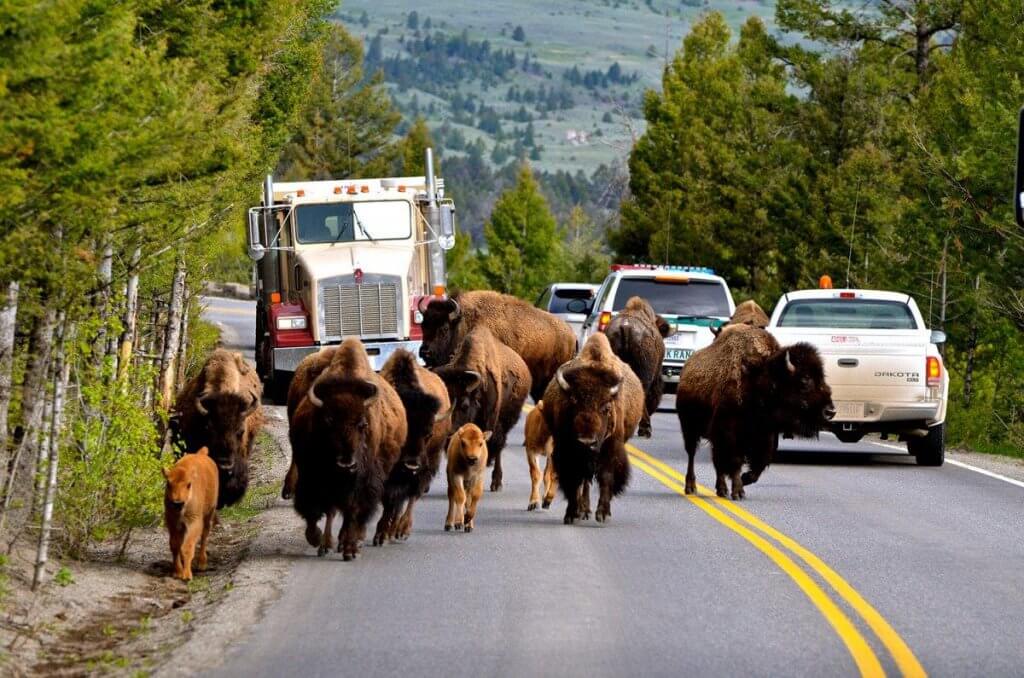
Young calves join the traffic jam on Yellowstone highways, keeping right up with their mothers. Photo credit Daniel Kleiman.
“Moreover, the onset of parturition in Bison at Yellowstone National Park has shifted from late March to mid-April over 55 years from 1941 to 1997, demonstrating that changes in the timing of parturition for Bison can occur over longer time scales.
“Whether the early births we observed indicates a shift in the timing of parturition in Bison from the Aishihik population is unknown. Showing this would require further monitoring for early-born calves
“Although the onset of parturition in southern populations of Plains Bison normally occurs around early April to match the food availability, early births in the Aishihik and Nahanni populations have occurred while temperatures were below freezing at night and patches of snow persisted on the ground, indicating a mismatch between early births and spring green-up of forage resources.
“Generally, calves born earlier in the season may have an advantage over their cohorts that may last their lifetimes, but those born early in suboptimal conditions, possibly because their mothers were in poor body condition, may not have an advantage. In the latter case, the prognosis for their survival is poor.
“Similarly, the fate of late-born Bison is unknown. However, the late-born calves observed had survived the critical neonatal period (the first month after being born) during early winter at high latitudes, indicating that they may survive the rest of the winter.
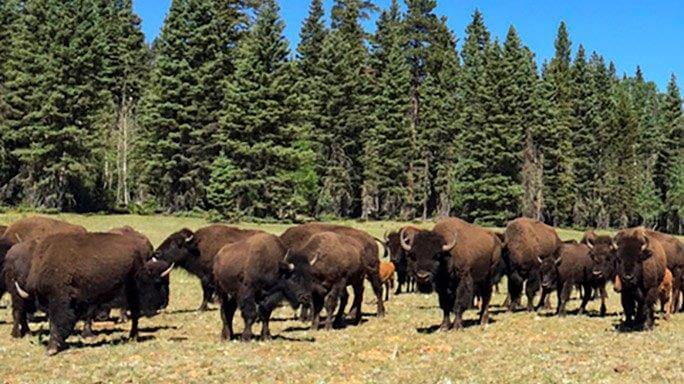
Early calves. Only a few ‘red dogs’—as forest rangers call them—arrive early in the herd.
“In other instances of late-born calves, it has been assumed that the mother was in poor physical condition during the peak of conception and bred later in the season when her body stores had increased. However, the fate of these early- and late-born Bison is unknown.
“In conclusion, our observations are of scientific interest because they provide new information on apparently extreme birth dates for high-latitude Bison, and they demonstrate some flexibility in the onset of parturition in these populations.
“It appears that parturition at high latitudes may begin in late March and, in exceptional cases, extend into December. Overall, however, the timing of parturition for Bison appears to be largely synchronous with spring green-up, albeit with a wider range of dates than for other ungulates in the region.”
Hmm. That’s interesting. As the resident of a northern state, I’m wondering. People who live here know well that spring green-up doesn’t always arrive at the appointed hour or date.
Hard winters sometimes hit—and bring a late spring. An easy winter might mean an early spring. Or quite the opposite.
In the Yukon weather might be even more extreme and unpredictable. So is there some leeway on how many gestation days occur? When spring comes early does gestation speed up to less than 9.5 months? And hard winters with late springs drag births out longer?
Someday will researchers link dates of first green-up with Birth Synchrony and tell us about the weather when Buffalo declare an early spring? Or a late one?
Studies of the timing of births in Plains Bison in more southern latitudes and other ungulates, such as wild sheep, provide evidence of annual variation of more than 2 or 3 weeks from one year to the next. Depending on what?
Definitions
Birth Synchrony: The short period of time in the spring during which most buffalo calves are
born. Considered an evolutionary adaptation that insures most calves are born at the time they are most likely to survive.
Parturition: The process of giving birth—also known as labor.
Colostrum: The mother’s first milk after giving birth—contains antibodies that protect
against infectious diseases.
Precocial: Means buffalo calves are born fully developed and able to follow their mothers and
the rest of the herd almost immediately after birth. They need only 7 or 8 minutes to
stand up.
Ungulates: Primarily large mammals with hooves (split or not-split) such as bison, elk, deer,
moose and horses.

Francie M Berg
Author of the Buffalo Tales &Trails blog




Very interesting. I grew up on the west side of Elk Island National Park in Alberta Canada and spent a lifetime studying them. I became a Sculptor and sculpting the Bison / Buffalo became a passion. Rick.